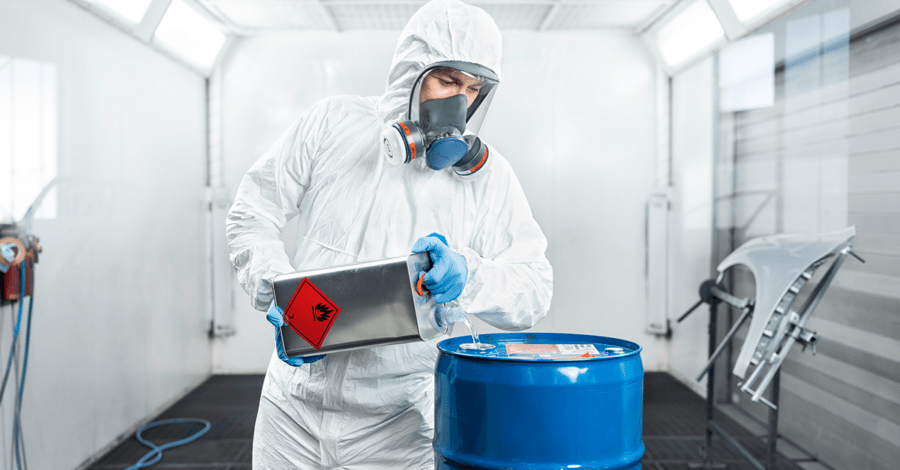
When combined with a full-face or half-face mask, a gas filter provides excellent respiratory protection against hazardous vapours and gases.
However, it is very important that you always use the correct type of filter, e.g. an ABEK filter. Only then can you be sure that you will be able to breathe safely and without any concerns in a (potentially) unsafe working environment.
But how to choose the correct gas filter?
Gas filters: a must in the workplace
Gas filters make sure that you do not inhale gases and vapours which have been or may be released during work.
These gases and vapours can be present both inside and outside the workplace. Some examples of these harmful substances are organic substances, such as sulphur dioxide, ammonia and mercury vapour.
Which gases and vapours a gas filter protects against depends on the type of filter. As with all respiratory protection equipment, gas filters must also comply with European standards.
Gas filters must comply with the EN14387 standard (formerly EN141).
What does an ABEK filter protect against?
There are single gas filters; which protect against one type of gas or vapour. And there are also multiple gas filters, such as ABEK filters.
These protect against several types of gases, organic and inorganic vapours, sulphur dioxide and ammonia.
An ABEK filter absorbs dangerous gases and vapours, enabling the user to breathe safely.
In some gas filters, there is a chemical reaction which blocks the incoming gases and vapours. That is called chemisorption.
Colour codes
Each gas filter has a specific colour code.
The colour code tells you which harmful gases and vapours the filter protects against.

There are a total of 9 colour codes.
For example, an ABEK filter with the colour code yellow protects against sulphur dioxide and hydrogen chloride, whereas orange means that the filter absorbs radioactive iodines.
First, you need to find out which gases and vapours are or could be released in your company's workplace.
Then look up which filter(s) to buy using the colour code.
Gas filter classification
The maximum amount of certain gases or vapours that could be released into the air varies from one situation to another.
Because of this variation in (possible) concentrations, there are two classes of gas filters. These classes indicate the maximum concentration of a gas or vapour that the filter can protect against.
For a class 1 filter, this concentration must not exceed 0.1% (1000 parts per million).
For class 2, the maximum concentration is 0.5% (5000 parts per million). The filter class is shown by the number after the letter(s) in the filter description, for example A2 or ABEK2.

Pro tip
The choice of gas filter is often specified in the MSDS sheet of the substance you work with.
How long should you use a gas filter?
Has a gas filter been opened but not used? In this case, you can keep it for a maximum of six months.
There are a number of additional factors which influence the service life of gas filters.
- The speed at which the wearer breathes;
- The concentration of the gas or vapour;
- The amount of gases;
- The air humidity;
- The ambient temperature.
The rule here is: the higher the value, the shorter the service life of the gas filter.
The size of the filter also affects its service life. The more activated carbon the filter contains, the longer it lasts.
An ABEK filter that contains twice as much activated carbon as a different brand will last twice as long.
When is a gas filter saturated?
Unlike, for example, a dust filter, it is not easy to determine whether a gas filter is saturated.
When a filter has become saturated, the user will be able to smell or taste the gas or vapour. This means the filter is allowing gas or vapour to pass into the mouth and lungs of the user.
The respiratory protection device being used is therefore no longer safe.
This is why you should replace a saturated gas filter with a new one immediately.
This only applies to a working environment with concentrations of gases you can smell or taste. If the user is not able to smell or taste the substance, you must never use gas filters.
What are combination filters?
There are also filters which not only protect against certain dangerous gases, but also against harmful substances, smoke and vapours: combination filters.
Combination filters can also be recognised by the colour code of the gases they protect against.

Combination filters and gas filters that protect against multiple types of gas may only be used for one type at a time. Also, you should not use the filter for one type of gas and subsequently for another. This can cause chemical reactions between the gases inside the filters.
An additional point of attention for combination filters: have you observed that one of the two filters - for dust or gas - has become saturated?
In which case, you should no longer use the combination filter!
Looking for an ABEK filter?
You can find your new ABEK gas filter on our website! Take a look at our wide range of gas filters.
Need advice? Contact us.